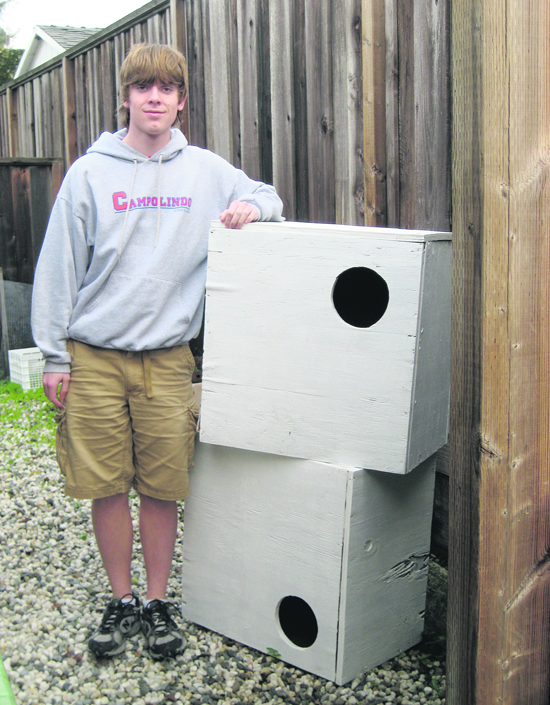
| ||||||
Brian Murphy, of the MDAS, facilitated the barn owl project. "Dan (Bernie) wanted barn owl boxes in the Commons for gopher, rat and mouse control. Kevin (Gustafson) was looking for a project. There was wood available from construction of the new Walnut Creek Library and edge braces for the inside of the box available from a Council election campaign signs. Then lumber available from a material recycler for posts to mount the boxes on as well as help available to cut the boxes from the material recycler," explains Murphy, "so Kevin's job was to assemble all of the resources available for his Eagle Scout project - we just brought the resources to Kevin's attention and he put them together."
"I didn't really know that much about integrated pest management until I met Mr. Murphy and began the project," says Gustafson, adding that he quickly became very interested in a method of dealing with pests without pesticides. "The process allows resident rodents to provide food for breeding barn owls," explains Murphy. One pair of owls with chicks may consume as many as 1000 rodents by the time the chicks leave the nest.
According to the California Council for Wildlife Rehabilitators, approximately 26 million years ago the first barn owl appeared on earth; and since then barn owls have reigned supreme as one of the most efficient winged hunters, and were the farmer's best friends when it came to rodent control.
For his project Gustafson worked cooperatively with others. "I was supplied with the blueprints by the Audubon Society. I then measured and cut the wood. Later my friends, many of whom are fellow Boy Scouts, and I assembled the boxes," he says. The boxes will be installed in both of Moraga's public parks is the coming weeks. "Mr. Bernie and I specifically picked locations that we felt would discourage people from messing with the owl boxes," says Gustafson, "also the boxes are 12 feet up in the air."
For Bernie, the owl box project is exemplary of how IPM works. "I learned about owls in a training session in Walnut Creek, and bats in an EBMUD publication," he explains, "That will be one of my next projects, getting bats to nest under the pedestrian bridge that connects the Moraga Commons to the library." A brown bat eats its own weight in insects each night; mosquitoes are a favorite food, and a bat can catch 1,200 of them in an hour. Bats also pollinate many plants and produce guano, a prized fertilizer.
"The Town of Moraga took the biggest leap of them all, and stands in front of all Contra Costa," says a proud Bernie, referring to Moraga's IPM policy. After the bats, Bernie plans to set raptor poles in strategic places in Moraga so hawks will perch and catch gophers coming out during the day. He is hoping to enroll Scouts to bring these projects to completion.
Bernie's efforts to eliminate all chemical use in public places in Moraga also include adding mosquito-eating fishes in Mulholland Open Space ponds and switching all of the Town's janitorial supplies to "green" chemical free soaps and cleaning supplies. "We will never go back," Bernie concludes.
Reach the reporter at:
Copyright
